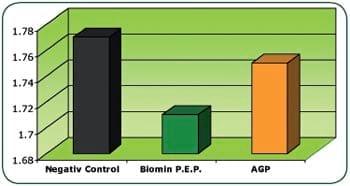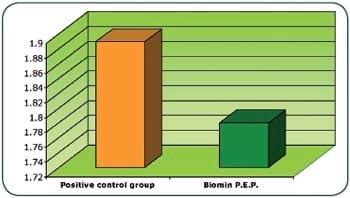Biomin® P.E.P.– Latest studies show improved Feed Conversion Rate (FCR)
Published: May 11, 2007
By: Arthur Kroismayr (BIOMIN)

Feed conversion is one of the most important factors to economically optimize animal production. Since feed commodity prices have recently been increasing, Feed Conversion Rate (FCR) must be optimized. Biomin® P.E.P. in animals’ diets increases nutrient utilization and stabilizes a healthy gut micro-flora.
Biomin® P.E.P. is an established phytogenic feed additive based on essential oils. The phytogenic substances present in Biomin® P.E.P. have positive effects on gut micro-flora of monogastric animals. Biomin® P.E.P. essential oils decrease the activity of disturbing bacteria. Scientific studies (Kroismayr et al., 2006) have shown that, for example, contents of ammonia or biogenic amines are decreased in the intestine when Biomin® P.E.P. is a part of the diets. This mode of action leads to higher supply of important nutrients (e.g. essential amino acids) for the animals. Many scientific trials and supported by field trials show that products from the Biomin® P.E.P. line have a beneficial impact on nutrient utilization. A healthy gut wall becomes an added benefit resisting the insults from possible pathogens.
Costs of demand for grains as alternative fuels have pressured price increases. Other factors, however, contribute to higher feed costs. High energy costs directly affect the demand of bio-energy
sources like maize, rice, sugar, and wheat.
Not only ‘waste products’ like manure are used in bio reactors, also high-quality products which have been used for animal nutrition are now valuable substrates for the generation of bio-energy. Some investment bankers now recommend that their customers invest in maize, for example, since they are sure that prices for that important grain will increase more than oil or gold prices. It is also known that wheat has a higher energy value per dollar than oil has.
Another important point is that bio ethanol production is supported by many national governments, especially in the U.S., where this market grew more than 20% in the year 2006.
This is one more reason why it is so very important to improve the feed conversion of livestock. Biomin® P.E.P. has proven in many studies that it has a substantial positive impact on nutrient metabolism and digestion. In this newsletter, I will introduce a few selected trials which demonstrate the impact of Biomin® P.E.P. on feed conversion in swine and poultry.
The first trial was conducted in 2005 at Nanjing University, China. One-hundred twenty piglets, weaned at 23 d of age, were randomly assigned to two dietary treatments: a negative control (no additives) and one with Biomin® P.E.P. 125 (125 g/t).
Results:
Supplementation of the diet with Biomin® P.E.P. successfully improved growth performance in piglets. After 50 days, piglets receiving Biomin® P.E.P. were 3.09 kg heavier (P=0.013) in comparison to the control group.
Feed conversion was also positively influenced by Biomin® P.E.P. (see Figure 1)
 |
| Figure 1: Influence of Biomin® P.E.P. on Feed Conversion Rate (FCR) in piglets. |
The higher growth rates and better feed conversion resulted in a calculated return on investment (ROI) of 11:1.
In conclusion:
Addition of Biomin® P.E.P. to piglets’ diets led to better FCR, improved performance, and higher profits.
A 42 day study at Kansas State University was conducted in 2006 using 192 weanling pigs (average age 22 d). An antibiotic growth promoter was compared to Biomin® P.E.P. 125 fed to nursery pigs.
Animals were allotted to four treatment groups: 1) negative control; 2 and 3) negative control + 125 g/ton of Biomin® P.E.P. 125; and 4) positive control (feed containing 140 g/ton of neomycin sulfate and 140 g/ton of oxytetracycline HCl; Neo/OTC).
Results:
Both feed additives led to higher growth performance of the animals. Compared to the negative control group (435 g/day), both groups receiving Biomin® P.E.P. 125 as well as the antibiotic group showed improved daily growth rates (477, 480, 502 g/day, respectively).
The study showed that FCR was best in the two groups with Biomin® P.E.P. 125 in the feed (see Figure 2).
In conclusion:
Addition of Biomin® P.E.P. to piglets’ diets led to better FCR, improved performance, and higher profits.
A 42 day study at Kansas State University was conducted in 2006 using 192 weanling pigs (average age 22 d). An antibiotic growth promoter was compared to Biomin® P.E.P. 125 fed to nursery pigs.
Animals were allotted to four treatment groups: 1) negative control; 2 and 3) negative control + 125 g/ton of Biomin® P.E.P. 125; and 4) positive control (feed containing 140 g/ton of neomycin sulfate and 140 g/ton of oxytetracycline HCl; Neo/OTC).
Results:
Both feed additives led to higher growth performance of the animals. Compared to the negative control group (435 g/day), both groups receiving Biomin® P.E.P. 125 as well as the antibiotic group showed improved daily growth rates (477, 480, 502 g/day, respectively).
The study showed that FCR was best in the two groups with Biomin® P.E.P. 125 in the feed (see Figure 2).
 |
| Figure 2: Effect of Biomin® P.E.P. 125 and Neo/OTC on Feed Conversion Rate (FCR) of piglets. |
In conclusion:
Biomin® P.E.P. 125 led to higher performance of piglets and improved FCR.
In a trial at Kasetsart Univesity, Thailand (2006) Biomin® P.E.P. 125 poultry was compared to the antibiotic growth promoter Flavomycin, 5 g/t in 1800 Ross broilers 1 day of age. Chicks were assigned to dietary treatments without any additives and those containing Biomin® P.E.P. poultry (125 g/t), and Flavomycin (5g/t).
Results:
After 45 days animals of both groups with feed additives in the diets showed better growth rates in comparison to the animals of the negative control group. While animals in the negative control group weighed on average 1895 g, chicken fed Biomin® P.E.P. 125 poultry weighed 1973 g and animals of the antibiotic group 1979 g. FCR was improved by Biomin® P.E.P. 125 poultry compared to the other treatments (see Figure 3).
Biomin® P.E.P. 125 led to higher performance of piglets and improved FCR.
In a trial at Kasetsart Univesity, Thailand (2006) Biomin® P.E.P. 125 poultry was compared to the antibiotic growth promoter Flavomycin, 5 g/t in 1800 Ross broilers 1 day of age. Chicks were assigned to dietary treatments without any additives and those containing Biomin® P.E.P. poultry (125 g/t), and Flavomycin (5g/t).
Results:
After 45 days animals of both groups with feed additives in the diets showed better growth rates in comparison to the animals of the negative control group. While animals in the negative control group weighed on average 1895 g, chicken fed Biomin® P.E.P. 125 poultry weighed 1973 g and animals of the antibiotic group 1979 g. FCR was improved by Biomin® P.E.P. 125 poultry compared to the other treatments (see Figure 3).
 |
| Figure 3: Influence of Biomin® P.E.P. 125 poultry and Flavomycin on Feed Conversion Rate (FCR) of broiler chicken |
In conclusion:
Biomin® P.E.P. 125 poultry led to better FCR than an antibiotic growth promoter (Flavomycin).
In 2003 Biomin® P.E.P. was investigated in a 60,000-broiler flock in Turkey. The trial lasted 42 days and theanimals were split into two treatments: 1) Avilamycin (10 ppm) and 2) Biomin® P.E.P. 1000 (1 kg/t).
Results:
After 42 days Biomin® P.E.P. increased final weight (2387 g) of animals compared to the positive control group (2245 g). FCR was best in the group with Biomin® P.E.P. in the diets (see Figure 4). The calculated European Efficiency Factor (EFF) was also higher for the animals fed Biomin® P.E.P. compared to the AGP group (315 vs. 282).
Biomin® P.E.P. 125 poultry led to better FCR than an antibiotic growth promoter (Flavomycin).
In 2003 Biomin® P.E.P. was investigated in a 60,000-broiler flock in Turkey. The trial lasted 42 days and theanimals were split into two treatments: 1) Avilamycin (10 ppm) and 2) Biomin® P.E.P. 1000 (1 kg/t).
Results:
After 42 days Biomin® P.E.P. increased final weight (2387 g) of animals compared to the positive control group (2245 g). FCR was best in the group with Biomin® P.E.P. in the diets (see Figure 4). The calculated European Efficiency Factor (EFF) was also higher for the animals fed Biomin® P.E.P. compared to the AGP group (315 vs. 282).
 |
| Figure 4: Influence of Biomin® P.E.P. and Avilamycin on Feed Conversion Rate (FCR) of broiler chicken. |
In conclusion:
Biomin® P.E.P. performed better than the antibiotic growth promoter (Avilamycin).
Summarizing conclusion:
Biomin® P.E.P. helps to save valuable energy and feed costs!
These few trials are only examples of how Biomin® P.E.P. improves FCR in monogastric animals. The mode of action of BIOMINS’ phytogenic product line guarantees excellent gut health status and digestion, resulting in high nutrient uptake and feed efficiency.
Biomin® P.E.P. helps our customers to save money for cost-intensive nutrients and commodities. It is a valuable tool to keep animal husbandry profitable.
Literature
Biomin® P.E.P. performed better than the antibiotic growth promoter (Avilamycin).
Summarizing conclusion:
Biomin® P.E.P. helps to save valuable energy and feed costs!
These few trials are only examples of how Biomin® P.E.P. improves FCR in monogastric animals. The mode of action of BIOMINS’ phytogenic product line guarantees excellent gut health status and digestion, resulting in high nutrient uptake and feed efficiency.
Biomin® P.E.P. helps our customers to save money for cost-intensive nutrients and commodities. It is a valuable tool to keep animal husbandry profitable.
Literature
1. Kroismayr, A., Sehm, J., Plitzner, Chr., Windisch, W. (2006): Effect of an essential oil blend (oregano, anis, citrus peels) or Avilamycin on growth performance, microbiological and histological parameter and mRNA expression of inflammatory and apototic genes in the gut of weaned piglets. , Proceedings of the Society of Nutrition Physiology: Gesellschaft für Ernährungsphysiologie, 15, 47-47; ISBN: 3769040996.
2. Kroismayr, A., Sehm, J., Windisch,W. (2006): Efecto comparative de los aceites escenciates y un antibiotico promoter de crecimiento en la ganancia de peso y parametros intestinales de los lechones destetos. In: Asociacion Colombiana de Porcicultures, Congreso Latinoamericano de Porcicultura, 17–19. July 2006, Medellin, 1-6.
3. Sivropoulou, A., Papanikolaou, E., Nikolaou, C., Kokkini, S., Lanaras, Tt.; Arsenakis, M. (1996): Antimicrobial and cytotoxic activities of Origanum essential oils. Journal of agricultural food chemistry 44, 1202-1205.
4. Steiner, Tt., Zhang., C., Kroismayr, A. (2006): Evaluierung eines phytogenen Futterzusatzstoffes. Vet med report Sonderausgabe V6, August 2006.
5. Steiner, Tt. (2006): Managing Gut Health – Natural Growth Promoters as a key to animal performance. Nottingham University Press, Nottingham, UK (ISBN-13: 978-1-904761-45-7).
6. Wenk C. (2003): Herbs and botanicals as feed additives in monogastric animals. Asian-Australian Journal of Animal Sciences 16 (2), 282-289.
Author:
Name: Arthur Kroismayr
Position: Product Manager
Education: 1996 - 2002 University of Natural Resources and Applied Life Sciences, Vienna.
Master thesis: Phytogenic feed additive in Broilers Since 2003 PhD thesis in animal nutrition (Biomin® P.E.P. in weaning piglets)
2003 - 2005: Project Manager, Biomin GmbH
Since 2005: Product Manager Biomin® P.E.P., Biomin GmbH
Related topics
Join to be able to comment.
Once you join Engormix, you will be able to participate in all content and forums.
* Required information
Would you like to discuss another topic? Create a new post to engage with experts in the community.
Create a post




.jpg&w=3840&q=75)